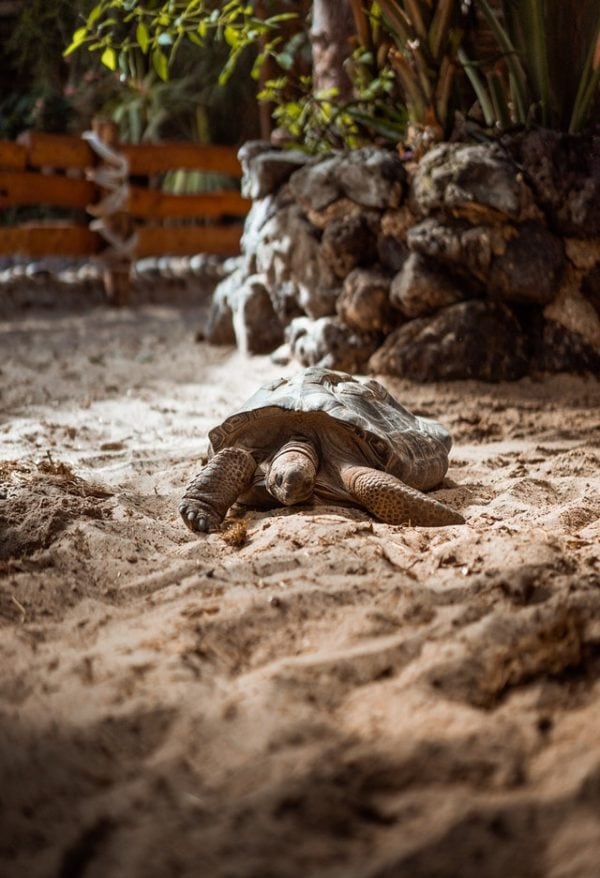In this article, we explain how to determine if a turtle is dead or simply hibernating, a process known as brumation. Key indicators include the turtle’s response to external stimulation, body temperature, odor, eye condition, maggot and fly infestation, and the state of its skin and shell. These signs help differentiate between a turtle in brumation, which is a dormant state during colder periods, and one that has passed away.
Like every other pet, a Turtle also becomes a beloved part of the family. It can get very tricky to tell whether they have passed away or not because they are docile and dormant for the most part of their life. Given the fact that a turtle is usually slow on the uptake and has a very long life, deducting whether it has passed away or not is crazy difficult.
Want to get home a pet turtle? Read all about taking care of one here: How to take care of a turtle.

There are times when it goes hiding into a shell or a part of the tank where you cannot discover it immediately. And if it so happens that you discover the turtle on the bed of the tank or hiding under a few rocks, chances are that the turtle could be dead or it could be going through a process called brumation. If your turtle is not being responsive to certain stimuli, it could very well be because it is going under a hibernating sort of a process that is quite common to cold-blooded reptiles
Table of Contents
How to tell if a turtle is dead? [4 Quick Ways]
To identify if a turtle is dead, you can:
- Stimulate it by poking or prodding it.
- Check if it smells bad.
- Put pressure on the cloacal region.
- Look for signs of breathing.
Understanding the brumation process
A few creatures in the animal world go through a slowing down process in the cold seasons. Around that time of the year when the temperature takes a dip, animals go through a period of decreased activity. In warm-blooded animals like mammals, this process is called hibernation. When a mammal goes into hibernation, it goes into a deep sleep-like condition during the colder months and wakes up only rarely in between. They go days and weeks without food. The same process of slowing down in the cold-blooded reptiles is called Brumation.
During brumation, reptiles bury themselves in the soil, go into a deep slumber and stop eating and moving around. They may however wake up in between to drink water or hydrate. But otherwise, they stay put through the Brumation for a long time. Turtles are known to go through the Brumation process and it is said to be crucial for their optimal reproductive health. Typically, the cold period aka winter lasts between October and April and a turtle’s Brumation lasts through that entire time in the wild.
In captivity, however, brumation lasts for a shorter period because the temperature changes are not very extreme. Since the temperature is maintained steadily with some mild variations, brumation is mostly undertaken for short periods. Irrespective of where the turtles are living though, they start eating less and slowing down in the month of October. The ideal temperature for brumation is 41 degrees Fahrenheit. Any temperature fluctuations below 35 degrees Fahrenheit and above 60 degrees Fahrenheit can be dangerous to the turtle.
Your pet turtle is a fun and playful animal, read all about how to keep it engaged and play with it: How to play with a turtle.
How to know if your turtle is dead?

To determine if a turtle is dead, observe its response to touch and check for a foul odor, which indicates decay. Look for any maggots or flies, which are signs of death. Also, examine the turtle’s eyes and skin, as changes in these can indicate death rather than hibernation.
It is inevitable that sometimes a pet you so dearly own may pass away. In the case of it being a mammal or even certain smaller pets like the fish, you take a look at their condition and tell if they are dead or not, there is hardly any room for ambiguity there. But that is not the case with the turtle. A turtle’s physiological design is such that it becomes very difficult to ascertain if it has really passed away or is undergoing brumation.
Given that most of the turtle’s body is hidden under its exoskeleton, it becomes very difficult to determine if your turtle is actually dead. There are, however, certain signs you can look for specifically to make sure of the turtle’s condition.
Response to external stimulation
A turtle going through brumation is faintly aware of everything that is happening in its vicinity. Although it goes into a hiding place to slow itself down, if external stimuli are generated, they are most likely to respond albeit faintly. You can try tugging at the turtle’s limbs gently or pressing on its underbelly. You can also carefully try flipping them on their shells so that they are on their back. Despite all this being done, your turtle continues to be still and not move, it is most likely dead.
Body Temperature
This method is slightly tricky and cannot be used as standalone proof of a turtle being dead or under brumation. Upon touch, if the turtle is unusually cold, it can be deduced that it is dead. But there is a twist in the tale here. Turtles that are brumating are also known to lower their body temperatures a fair bit. Hence, being cold to the touch cannot prove conclusively if your turtle is dead or not but coupled with other factors, it can help you decide.
Odor
Just like any other animal, as soon as the turtle dies, it starts decomposing. Just as well, along with decomposing, other things like bloating and smelling also begin pretty much immediately. The odor that emanates from a dead turtle is usually foul-smelling and is a definite indicator of the creature passing away.
Eyes
Physiologically, a turtle goes through certain changes when it dies. Sadly, certain changes corroborate other health conditions as well so it cannot be definitely used as an indicator of the turtle passing away. One such change is seen with the eyes. Very thoroughly check the eyes of your turtle. Usually, deep and sunken eyes indicate that the turtle has passed away. But as mentioned earlier, sunken eyes could also be an indication of heavy dehydration in the turtle’s body. Hence you may need to confirm other conditions to confirm your doubts.
Maggot and fly infestation
If your turtle is infested with flies and maggots, it is most certainly dead. During brumation the turtles immune system slows down along with other life processes. So it is possible that maggots breed on any injuries that they may have sustained during Brumation but in most cases, a maggot infestation points to a dead turtle.
Skin and Shell
Brumation does slow down life processes but it does not make the appearance of the turtle change. So, if you notice upon checking that your turtle’s skin is shriveled and saggy, it is quite possible that it is dead. Shriveled or abnormal-looking skin is a byproduct of decomposition. Along with that, if you see that the shell or the carapace of the turtle starts to lose color or looks rotten, it is most likely that the turtle has died. It is important to note that in a brumation turtle, the shell tends to go softer. If you are checking for signs on the shell to see if your turtle has died, a soft shell does not imply dead. Rotten is dead, due to decomposition.
Limp limbs
Like we mentioned earlier, a turtle undergoing brumation may seem like it has passed but it has most of its reflexes intact even if they are slow on the uptake. A very simple way of checking if the turtle is dead or not is to pick it up. Even under brumation, the turtle will twitch the limbs only slightly but if the turtle is dead, the limbs will just stay unmoved and lifeless.
How do turtles look when they die?

When a turtle passes away, there are certain characteristic changes that happen to its body looking at it which you can probably deduce that your pet has passed away.
The following are the changes that the turtle goes through when it dies:
- Sunken deep-set eyes
- Lifeless legs
- Rotten Exoskeleton
- Shrivelled skin
- Loose saggy skin overall
FAQ’s
When a turtle is under Brumation, its rate of metabolism slows down drastically and it completely stops moving. So to say them apart from a dead turtle becomes a task in itself. There are certain conditions you can check for to see if your turtle is actually hibernating or dead. A dead turtle will have a rotten and shriveled shell and skin, deep sunken eyes, cold to touch, will emanate bad odor, and most likely be covered in flies or maggots or floating in the tank if dead for more than a day in the water. Brumating turtles, on the other hand, are cold to the touch but they respond to external stimulation and their skin appearance remains normal.
If your turtle is not moving, then two options are in play. Either your turtle has slipped into a hibernation-like state for reptiles called Brumation or the worse, it passed away. During cold months especially between October and April, turtles are known to undergo Brumation where they exhibit slow to nil movement. They go without food and water for days together and resurface once in a while to hydrate only to go back to brumating.
If your turtle has passed away, then sadly there is nothing much that can be done to make sure it is living again. In some cases, where the turtles have supposedly died due to choking, there have been instances of reviving them through CPR but this happens only very rarely especially if the cause of death is indeed choking.
Summary
Losing a family pet can be all sorts of painful and especially if it is a turtle who usually lives along as a family pet for years together. Since we love these pets, we want them to live the same duration as we do but that is sadly not possible. With a pet turtle, the feeling is no different but do not be alarmed as soon as you see your beloved pet not moving. Check for the signs and talk to your vet before thinking about the worst.
Ever wondered how big a Red-Eared slider Turtle could get in captivity? You won’t believe it. Read all about it here: How big do red eared slider turtles get.

1 thought on “How to Tell if a Turtle is Dead Or Hibernating?”
I was given a aquarim. …. they left it on the porchwas not awear that there was turtle in it was out there for 3 days. The tempature has not been above 32. I brougt the tank in and started to clean it thats when i found it . Doesen’look dead but can’t really tell. Hel